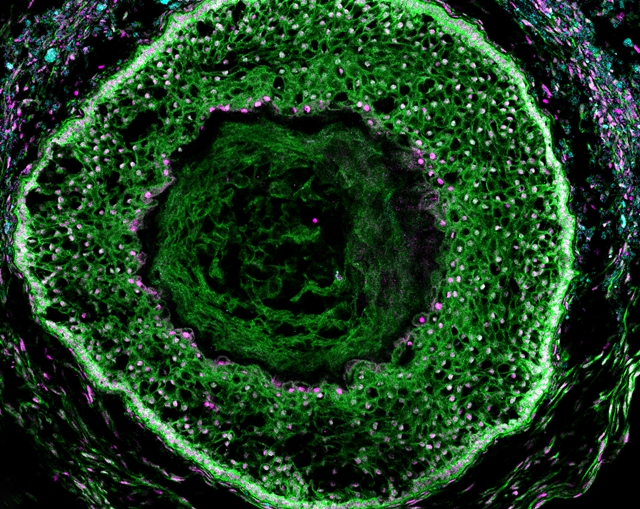
Ovaroid after 70 days, with follicles and a characteristic ring of granulosa-like cells arranged around a central cavity (Wyss Institute, Harvard University)
21 Feb. 2023. A university lab created and licensed to a biotechnology company a model human ovary made of functioning cells for female reproductive health applications. Researchers from the Wyss Institute for Biologically Inspired Engineering at Harvard University and Duke University demonstrate their model ovary organoid in today’s issue of the journal eLife.
Organoids are three-dimensional models of functioning cells and tissue grown in the lab from stem cells. The Wyss Institute is among the pioneers in development of organoids for diagnostics and therapies. In Feb. 2022, Science & Enterprise reported on kidney organoids created at Wyss Institute labs, produced with 3-D printing, and licensed to a start-up company developing engineered kidney tissue for people with kidney failure.
The human ovary organoid, called the ovaroid, is a project from the lab of Harvard geneticist and serial entrepreneur George Church, senior author of the eLife paper. Church and colleagues produced the ovaroid as a tool for academic labs and companies working in women’s health, addressing infertility and diseases of the reproductive organs. The Wyss Institute cites data from 2010 showing some 48.5 million couple worldwide experience infertility, with many couples relying on techniques such as in-vitro fertilization or IVF to help conceive. However, IVF is a complex procedure, often with associated health risks, and a high financial cost — $15,000 to $30,000 according to Forbes magazine.
The biotechnology enterprise Gameto in New York was formed in 2020 to offer cell engineering solutions for women’s reproductive health, including infertility, ovarian diseases, and the burden of menopause. Gameto sponsored research at Wyss Institute on creating a fully human ovary model; most current ovary models say the authors combine human germ or reproductive cells, with supporting somatic cells from mice. The researchers began with human induced pluripotent stem cells, also known as adult stem cells, programmed into germ cells.
The next stage required producing somatic cells, in this case granulosa cells, transformed from stem cells. Granulosa cells in the ovary release hormones like estrogen and progesterone, and support production of ovarian follicles, small sacs of fluid in ovaries that contain eggs. To induce stem cells to transform into granulosa cells, the team first identified 35 candidate transcription factors, proteins that attach to DNA and govern gene expression, turning genes on and off. The team then tested each of the 35 transcription factors by inserting genes coding for those proteins into the genomes of the adult stem cells.
Co-cultured granulosa and germ cells together
The tests looked particularly for transcription factors leading to production of FOXL2 proteins, responsible for growth and proliferation of granulosa cells producing hormones. The team’s tests identified three transcription factors, which in two different combinations boosted FOXL2 protein production. With these key transcription factors, the researchers induced production of granulosa cells exhibiting structures similar to follicles found in ovaries.
The team then co-cultured the precursor granulosa and germ cells together, which began forming ovary tissue. After eight days, the lab-grown ovary tissue began expressing DAZL proteins, an indicator of germ cell activity, and after 16 days displayed follicles. By day 70, the ovaroids exhibited follicles of different sizes, including those capable of supporting eggs.
“Creating the granulosa cells on their own was a significant accomplishment,” says Christian Kamme, co-lead author and now a vice-president at Gameto in a Wyss Institute statement, “but making an ovaroid out of only granulosa cells wouldn’t tell us anything about their ability to support the maturation of germ cells, which was what we wanted to be able to study in vitro.”
Gameto is licensing the ovaroid technology from Wyss Institute to speed development of therapies for infertility and ovarian health. The company plans to offer a process adapting the ovaroid technology for producing eggs in less time and with fewer supporting hormones, now in preclinical development in Spain.
More from Science & Enterprise:
- Implanted Organoid Connects to Brain, Reacts to Visual Cues
- Immune Organoid Company Raises $4.3M in Seed Funds
- Human Organoids Show Drug Activity in Lab Animals
- Synthetic Antibodies to be Designed with Organoids
- Organoids Developed for Precision Cancer Treatments
We designed Science & Enterprise for busy readers including investors, researchers, entrepreneurs, and students. Except for a narrow cookies and privacy strip for first-time visitors, we have no pop-ups blocking the entire page, nor distracting animated GIF graphics. If you want to subscribe for daily email alerts, you can do that here, or find the link in the upper left-hand corner of the desktop page. The site is free, with no paywall. But, of course, donations are gratefully accepted.
* * *

 RSS - Posts
RSS - Posts
You must be logged in to post a comment.